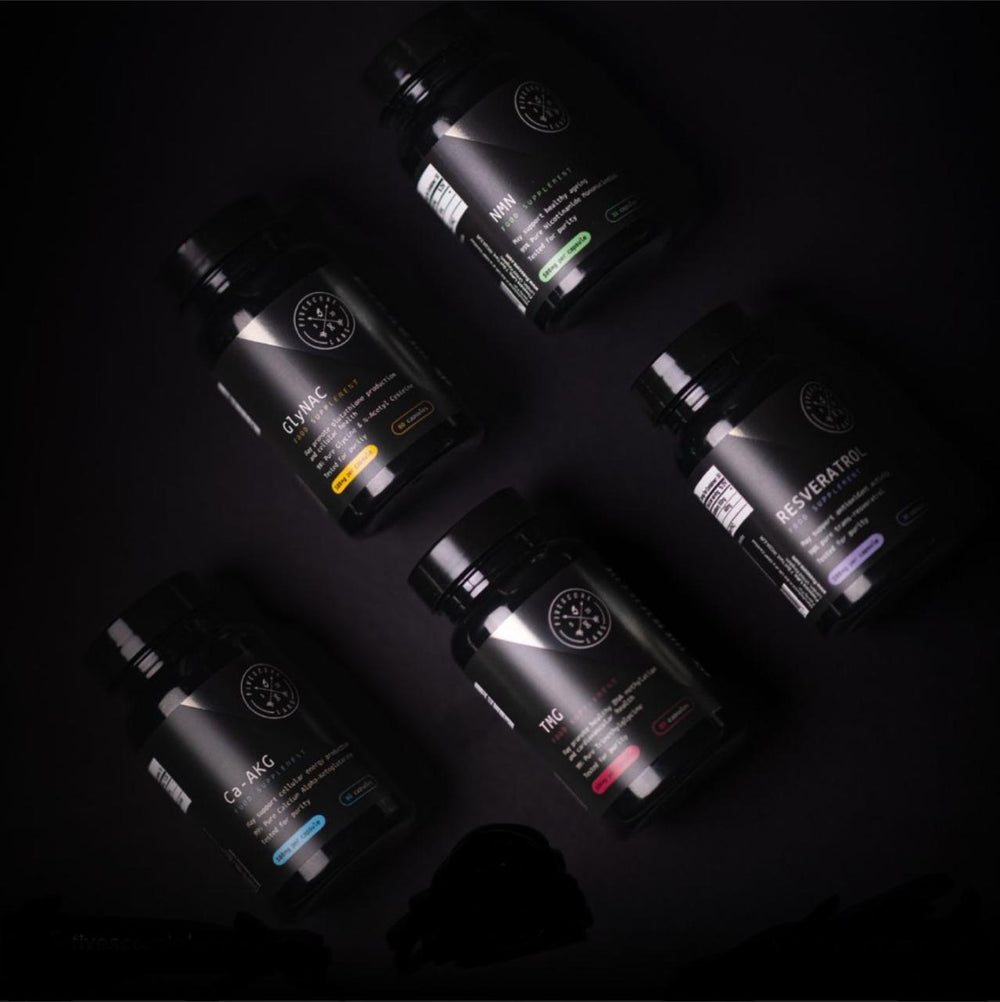Intestinal Bacterium and NMN Synergistically Enhance Skin Protection

This combination may promote healthy skin aging despite harmful UV radiation
Source: NMN.com
By Brett J. Weiss
Highlights
- NMN and the gut bacterium L. fermentum eliminate harmful molecules called free radicals.
- The combination of NMN and an intestinal bacterium synergistically protects mouse skin from harmful ultraviolet radiation.
The skin is one of the most complex organs in our bodies and has an integral connection to the gut. Skin anti-aging has become a research hotspot of many scholars and clinicians and has captivated the attention of many beauty seekers. So, what if we could harness what we know about this connection to improve skincare?
Zhao and colleagues from the Chongqing University of Education in China published a study in Frontiers in Pharmacology showing that combining an intestinal bacteria with nicotinamide mononucleotide (NMN) synergistically improved mouse skin damage caused by ultraviolet (UV) irradiation. They found that mice that drank water containing NMN (300 mg/kg) along with Lactobacillus fermentum extract saw greater protective effects than either NMN or the bacterium individually. These findings suggest that NMN and the bacterium provide skin protection through different pathways and that using them together may provide a means to enhance skin health.
The Anti-Aging Properties of NMN and L. fermentum
Photoaging is premature aging of the skin caused by repeated exposure to UV radiation, primarily from the sun but also from artificial UV sources. The occurrence and development of skin photoaging mediated by UV radiation involve multiple pathways, including inflammation and responses to oxidative stress. Studies have shown that intestinal bacterial composition can modulate skin inflammation and that skin UV radiation exposure alters the gut bacterial composition. Figuring out how to utilize the skin-gut connection could enhance the way we protect our skin from the sun’s harmful ultraviolet rays.
L. fermentum bacteria have been shown to balance the composition of intestinal bacteria (the microbiome). This intestinal bacterium also can enhance the immune system, lower cholesterol levels, and reduce the presence of harmful molecules called free radicals that cause oxidative stress. The potential anti-aging properties of this intestinal bacterium along with its ability to clear free radicals has drawn the attention of researchers looking for ways to enhance skin protection and health.
Another antioxidant and anti-inflammatory compound is NMN, which boosts levels of a crucial molecule for energy production and maintenance of cell health called nicotinamide adenine dinucleotide (NAD+). There’s compelling evidence that taking NMN reduces free radicals and inflammation in organs like the liver and also provides anti-aging benefits.
Some reports indicate that both NMN and L. fermentum have a protective effect on the skin damaged by UV. For these reasons, Zhao and colleagues decided to test the protective effects of NMN and L. fermentum on skin damaged by UV radiation.
NMN and L. fermentum Synergistically Boost Free Radical Clearance
To test their antioxidant potential, Zhao and colleagues mixed NMN and the contents of the intestinal bacteria in test tubes with free radicals and measured their ability to absorb the free radicals, also known as free radical scavenging. They found that mixing NMN and the intestinal bacteria together resulted in better free radical absorption than either NMN or the bacteria alone. This combination also outperformed vitamin C, which is known to be an excellent scavenger. Since free radicals in skin cells play key roles in UV radiation-induced aging, their elimination by NMN and the bacteria may illustrate how the combination of supplements protects skin from harmful UV radiation.

(Zhou et al., 2021 | Frontiers in Pharmacology) NMN and the intestinal bacterium L. fermentum synergistically enhance free radical elimination. Graphs (A), (B), and (C) depict how well 3 different free radicals — OH, ABTS, and DPPH — were absorbed by NMN, L. fermentum (L), NMN plus L. fermentum (NMN+L), and Vitamin C (VC). Since vitamin C is known well for eliminating free radicals, the researchers compared its free radical absorption (scavenging) ability with the other treatments. Interestingly, the NMN plus L. fermentum treatment provided better absorption for each of the three free radicals, indicative of effective scavenging. The bottom right graph (D) illustrates the total concentration of free radicals that each treatment absorbed (antioxidant capacity), with the NMN plus L. fermentum treatment absorbing the most. These findings indicate that NMN plus L. fermentum treatment induces a substantial elimination of free radicals.
Combining the Two Substances Substantially Enhances Skin Protection
Zhao and colleagues then moved their experiments from test tubes to live animals. They wanted to find out whether the free radical-reducing properties of the supplement combination could preserve skin tissue integrity in mice following intense, two-week UVB radiation exposure. Although NMN and L. fermentum had noticeable effects on their own, the research team found that mice treated with the combination of the two substances showed preserved skin tissue similar to that of mice not exposed to UVB radiation. By looking at the skin under the microscope, Zhao and colleagues could see that the treatment combination significantly preserved the dermal layer of the skin — a blood vessel-containing layer just under the surface — similar to that of mice without UVB radiation exposure.

(Zhou et al., 2021 | Frontiers in Pharmacology) NMN and L. fermentum supplementation synergistically improve skin thickness from harmful UV radiation. The images in (A) and (B) show cross-sections of mouse skin exposed to harmful UVB radiation with and without the animals taking supplements by mouth. In (A), the arrows point to the dermal layer of skin, a skin layer with connective tissue, blood vessels, oil and sweat glands, nerves, and hair follicles. The Model group in (A) shows that mice not treated with any supplement have the thinnest dermal layer after UVB radiation exposure. The dermal layer thickness of the NMN plus L. fermentum-treated mice is comparable to that of normal mice, as shown in the graph (D). The arrows in (B) point to collagen fibers stained blue-violet. The normal group had a high number of collagen fibers with an even and orderly distribution. The model group exposed to UVB radiation without any supplements had substantially fewer collagen fibers. The collagen fibers present in the model group showed breaks and were shrunken. The NMN plus L. fermentum-treated group showed increased collagen fibers that were more orderly with almost no shrinkage or breakage after UVB radiation exposure.
Moreover, the number of mast cells — cells indicative of inflammation — in the dermal skin layer increased four times following UVB radiation exposure. Supplementing with NMN and L. fermentum substantially reduced the number of mast cells so that they only increased about two-fold after intense UVB radiation exposure. So, the combination treatment provided better tissue preservation than NMN or the bacteria alone, indicating a synergistic protective effect.

(Zhou et al., 2021 | Frontiers in Pharmacology) NMN and L. fermentum synergistically reduce immune cell infiltration caused by harmful UV radiation. The arrows in (C) point to mast cells – cells associated with skin inflammation – that are stained as small, blue dots. Normal mice have far fewer mast cells than the Model mice exposed to harmful UVB radiation. The NMN plus L. fermentum treatment significantly reduced the number of mast cells in the skin after harmful UVB radiation exposure as shown by graph (E). These findings show that the NMN and L. fermentum supplementation substantially enhances skin structure and organization following skin UVB radiation exposure in mice.
NMN and the Intestinal Bacteria Confer Benefits Through Distinct Pathways
Previous research has shown that NMN enhances NAD+ biosynthesis to ameliorate diseases in mice through activating enzymes that maintain cell health and promote free radical removal like sirtuins. Understanding the protective effect of L. fermentum remains more elusive, though, and Zhao and colleagues say it may be related to the anti-inflammatory effects of its metabolites like short-chain fatty acids. The research team adds there’s still a great need to reach a better comprehension of the bacterium’s beneficial effects, especially when it’s combined with NMN. Moreover, we need to conduct human studies to show how effective the combination of these substances is.
Zhou X, Du HH, Ni L, Ran J, Hu J, Yu J, Zhao X. Nicotinamide Mononucleotide Combined With Lactobacillus fermentum TKSN041 Reduces the Photoaging Damage in Murine Skin by Activating AMPK Signaling Pathway. Front Pharmacol. 2021 Mar 25;12:643089. doi: 10.3389/fphar.2021.643089. PMID: 33841160; PMCID: PMC8027253.
At Fivescore Labs, we are constantly curating the most relevant studies and articles around human longevity sourced from the public domain.
